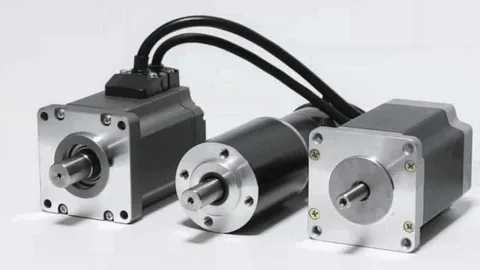DC Electric Motor | Its Working Mechanism, Varieties, Difference Between AC & DC Motors
DC electric motors are important across different sectors, from industrial equipment to cars. They enable accurate control and efficient performance, which is why they are preferred in automation, robotics, and other sophisticated systems. If you have ever been curious about what is the function of a DC electric motor, the difference between a DC and electric motor, the four classifications of a DC motor, or which is superior, an AC or DC motor, this guide has got you covered.
What is the Function of a DC Electric Motor?
A DC electric motor transforms direct current (DC) electricity into mechanical movement. This is accomplished via electromagnetic processes, where movement is produced by the combination of a magnetic field and an electric current.
How a DC Motor Operates
There is an electric current passing through the armature which is the rotating portion of the motor.
Stator magnets generate electricity and their magnetic fields interact with the current.
Rotating movement is created as a result of the electromagnetic force produced.
With brushes and commutators in place, in brushed motors, a point of continuous rotation is achieved by change of current direction at the right time.DC motors find application in:
-Electric Vehicles (EVs)
-Industrial Machines
-Robotics
-Household Appliances
–Automated Systems
It is smooth speed control, instantaneous torque, and efficient operation in many precision applications which makes them so useful.
Is a DC Motor and an Electric Motor the Same?
A DC motor is one of the various types of electric motors. An electric motor is essentially a device which converts electrical energy into mechanical motion. They can primarily be subdivided into two:
DC (Direct Current) Motors – These runs using direct current. This type of motor is common in battery powered devices and in devices used for industrial automation.
AC (Alternating Current) Motors – This type operates by alternating current and is used in appliances and even in HVAC and large industry powered machines.
So to put it more in simpler terms, all DC motors are classified as electric motors, but not all electric motors work on a direct current supply. The main difference is in the kind of electrical supply used.
What Are the 4 Types of DC Motor?
DC Motors are grouped in classes based on the configuration of the motor winding or the method of generating torque. The four primary ones are:
1. Series DC Motor
How it Works: The field winding and armature winding are connected in series.
Characteristics:
High starting torque.
As the load increases, speed reduces.
Used in cranes, traction systems, and other heavy duty applications.
2. Shunt DC Motor
How it Works: The field winding is connected in parallel (shunt) with the armature.
Shunt DC Motor Characteristics:
Constant speed regardless of the load.
Lower starting torque compared to series motors.
Used in precision machines, conveyor belts, and lathes.
3. Compound DC Motor
How it Works: It is a combination of series and shunt motor.
Compound DC Motor Characteristics:
Better torque and speed regulation.
Able to work with varying loads.
Used in presses, elevators, and rolling mills.
4. Brushless DC Motor (BLDC)
How it Works: Brushless motors eliminate the use of brushes, employing electronic commutation instead.
Brushless DC Motor Characteristics:
Longevity and high efficiency.
Due to the absence of brushes, maintenance is less.
Used in home appliances, drones, and electric vehicles.
Each type has its own advantages depending on application considerations.
Which Is Better, AC or DC Motor?
The decision to use a DC (Direct Current) Motor or an AC (Alternating Current) Motor depends on the application. Each has distinct benefits and drawbacks.
Distinction Between AC and DC Motors
| Feature | DC Motor | AC Motor |
| Power Source | Direct Current (Battery, DC supply) | Alternating Current (Mains supply, Generators) |
| Speed Control | Easy and precise | Complex, requires frequency control |
| Starting Torque | High | Moderate (Induction) / High (Synchronous) |
| Efficiency | High in small applications | Better for large-scale applications |
| Maintenance | Requires more maintenance (brushed models) | Less maintenance, especially induction motors |
| Application | Electric vehicles, robotics, industrial automation | HVAC systems, household appliances, factories |
When to Go with a DC Motor?
For battery operated systems such as EVs and drones.
For applications requiring precise speed control.
When to Go with an AC Motor?
For use in constant speed appliances such as refrigerators and pumps.
For high power applications.
For low maintenance appliances.
Who Is Best?
DC motors prove extremely helpful for small scale repetitive tasks as they create faster results.
AC motors work better for large scale tasks which require high amounts of power.
Working examples around the world including their cars Tesla produces come equipped with electric motors.
Applications of DC Motors
Electric Vehicles (EVs)
When considering these motors it should be noted that its benefits include use in various day to day appliances such as :
Industrial Machinery
Employs precise control in conveyor belts, elevators, and assembly lines.
Household Appliances
Enhances operational efficiency in vacuum cleaners, blenders, and washing machines.
Robotics & Automation
Widely used in smart systems requiring speed control, robotic arms, and CNC Machines.
Renewable Energy Systems
Wind turbines and solar energy storage systems utilize them for efficient energy use.
The Advancement of DC Motors
Due to the growing popularity of electric vehicles, AI-powered automation, and renewable energy systems, there is a demand for more advanced DC motors. This is because of advancements in technology, such as with brushless DC motors (BLDC), which allow for greater efficiency and lower maintenance.
Improvements to the DC Motor
– Advanced structures that improve the output and reduce the loss of energy.
– AI powered automatic adjustments for the smart motor controllers.
– Better battery performance for portable devices and electric vehicles.
– Improved efficiency by capturing the lost energy during braking.
Conclusion
From electric cars to industrial machines, dc electric motors play an important role in today’s technology. Answers to the questions, “What does a DC electric motor do?”, “Is a DC motor the same as an electric motor?”, “What are the four types of DC motors?”, and “Which is better: AC or DC motor?” can all be found in the understanding of their uses. With the growing need for automation, transportation, and energy-efficient systems, dc motors are bound to become more important.




Post Comment